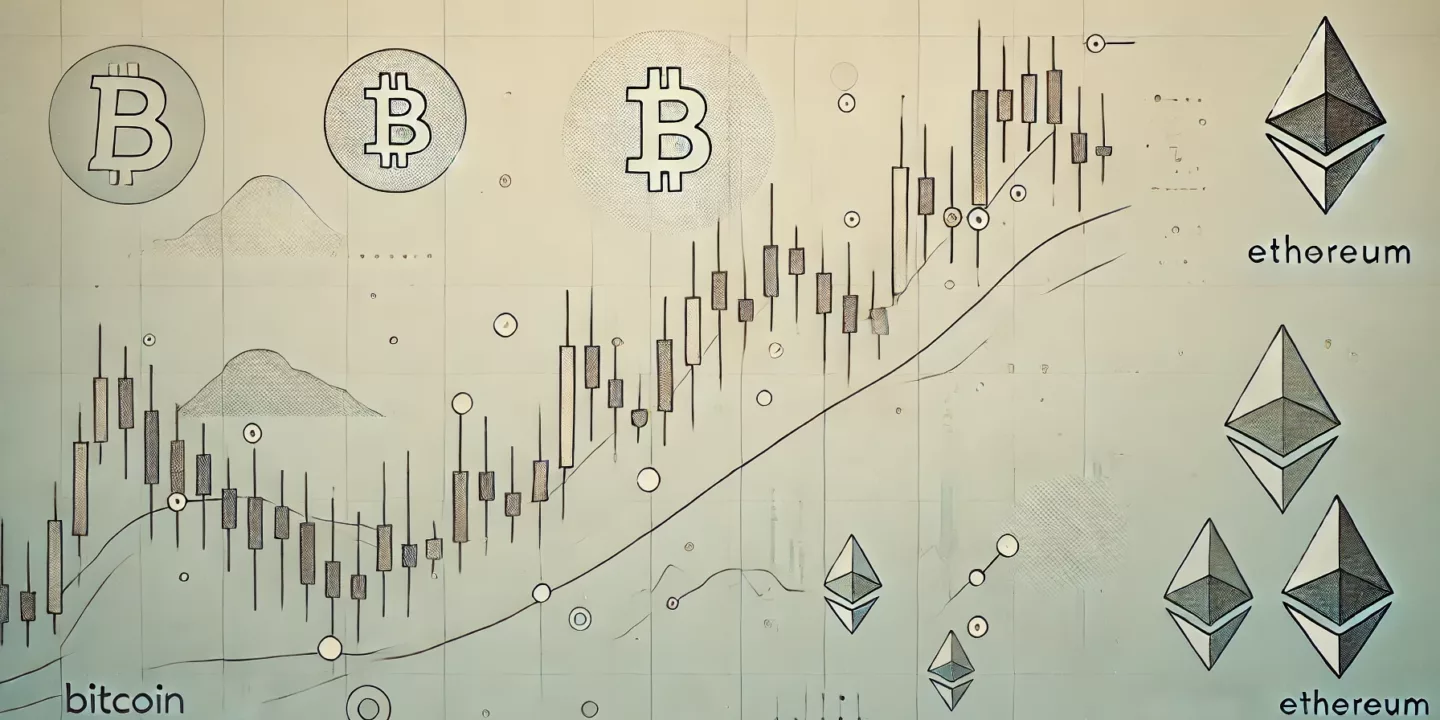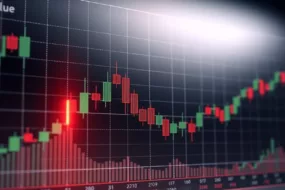
Cryptocurrency trading can be incredibly lucrative, but it requires a solid understanding of market trends. Recognizing these trends and effectively drawing trendlines can significantly improve your trading strategy.
In this guide, we’ll walk you through the essentials of identifying trends and how to use trend lines in crypto trading
Key Takeaways
- What are trend lines and why are they important
- Various advanced strategies to draw trend lines
- Common mistakes that most people make with trend lines
- How you can integrate trend lines in crypto trading
What is a Trend Line?
A trend line is a straight line that connects multiple price points on a chart, indicating the general direction of the market. Trend lines are used to identify and confirm trends, providing traders with visual cues about the overall market sentiment.
Types of Trend Lines
- Uptrend Lines: These are drawn by connecting a series of higher lows. An uptrend line signifies that the market is experiencing higher prices over time.
- Downtrend Lines: These connect a series of lower highs, indicating that the market is trending downward.
- Horizontal Trend Lines: These lines are drawn along areas of support or resistance, where the price remains relatively stable before breaking out or dropping.
How to Identify Trend Lines?
Identifying trend lines involves looking at historical price data and determining where the price consistently hits certain levels. Here’s how you can do it:
- Gather Historical Data: Use a reliable crypto trading platform to collect historical price data.
- Identify Peaks and Troughs: Look for repeated highs (peaks) and lows (troughs) in the price data.
- Draw Initial Lines: Connect two or more peaks or troughs with a straight line.
- Validate the Trend Line: Ensure that the line is touched by multiple price points. The more points it touches, the stronger the trend line.
How to Draw Trend Lines?
Drawing trend lines involves a few simple steps:
- Select Your Chart: Select a chart that most accurately depicts the period you are studying.
- Identify Key Points: Mark the significant highs and lows in the price data.
- Draw the Line: Join the important spots to create a line using a straight edge.
- Extend the Line: To forecast future price fluctuations, extend the line.
Tips for Drawing Accurate Trend Lines
- Use Logarithmic Scale: For long-term trends, a logarithmic scale can provide a clearer picture.
- Adjust for Time Frames: Different timeframes can reveal different trends. Always analyze multiple timeframes.
- Validate with Volume: Volume can confirm the strength of a trend. Higher volume usually indicates a stronger trend.
The Importance of Trend lines in Crypto Trading
Trend lines are more than just lines on a chart; they are valuable instruments used by traders to comprehend market dynamics. By visually representing the direction and strength of a trend, trend lines enable traders to make informed decisions about entry and exit points.
Enhancing Decision-Making
Using trend lines helps in enhancing decision-making by providing a clear visual representation of the market’s direction. Traders can use trend lines to identify potential support and resistance levels, which are crucial for setting stop-loss and take-profit orders.
Risk Management
Trend lines also play a vital role in risk management. By identifying the direction of the trend, traders can align their trades with the market’s momentum, thereby reducing the risk of trading against the trend. This alignment increases the probability of successful trades.
Providing Market Context
Trend lines provide context within the broader market environment. By observing multiple time frames and their respective trend lines, traders can better understand the overarching trends and avoid making decisions based solely on short-term market noise.
Supporting Technical Analysis
As a cornerstone of technical analysis, trend lines work in conjunction with other technical indicators. They help validate signals from tools such as moving averages, RSI, and MACD, offering traders a more comprehensive view of market conditions.
Advanced Techniques for Drawing Trend Lines
While basic trend lines are useful, advanced techniques can provide even deeper insights into market trends. Here are some advanced methods to consider:
Parallel Channel Lines
Parallel channel lines involve drawing a second line parallel to the trend line, either above or below it. In doing so, a channel is formed that may be used to find possible trading ranges and reversal points.
Fibonacci Retracement Levels
One can use trend lines and Fibonacci retracement levels to identify potential support and resistance levels. By drawing trend lines and then applying Fibonacci retracement levels, traders can predict where the price might retrace before continuing in the direction of the trend.
Trend Line Breakouts
Monitoring for trendline breakouts is another advanced technique. When the price breaks through a trend line, it can indicate a potential reversal or acceleration of the trend. This indication is frequently used by traders to join or exit positions.
Common Errors to Avoid in Trend Line Drawing
Even experienced traders can make mistakes when drawing trend lines. The following typical traps should be avoided:
Forcing Trend Lines
One of the most common mistakes is forcing a trend line to fit the data. A trend line should naturally connect the price points without being manipulated to fit a preconceived notion of the trend.
Ignoring Time Frames
Trend lines drawn on shorter timeframes may not be as reliable as those on longer timeframes. It’s essential to consider multiple timeframes to get a comprehensive view of the trend.
Overlooking Volume
Ignoring volume can lead to misinterpretation of trend lines. Volume confirms the strength of a trend, and a trend line without corresponding volume support may not be reliable.
Integrating Trend Lines with Other Technical Indicators
Trend lines are powerful on their own, but their effectiveness can be enhanced by integrating them with other technical indicators. Here are some signs to think about:
Moving Averages
By combining pricing data into a single, flowing line, moving averages can help determine the trend’s direction. Moving averages and trend lines together can produce a more reliable trading signal.
Relative Strength Index (RSI)
The RSI determines the magnitude and speed of a price’s movement. When used with trend lines, RSI can help confirm the strength of the trend and identify potential reversal points.
Moving Average Convergence Divergence (MACD)
The relationship between two moving averages is displayed by the trend-following momentum indicator known as MACD. Trend direction and strength can be verified by using MACD in conjunction with trend lines.
Conclusion
Mastering trend lines can significantly enhance your crypto trading strategy. By understanding how to identify and draw trend lines, you can gain valuable insights into market trends and make more informed trading decisions.
Mudrex provides a user-friendly cryptocurrency trading platform with tools for analyzing market movements and creating trend lines. It is a great option for both beginners and seasoned traders. Mudrex provides a great platform for beginner traders to start using. Go here to get the Mudrex app.
FAQs
How to find trends in crypto trading?
To find trends in crypto trading, analyze historical price data and look for consistent patterns of highs and lows. Using technical analysis tools, such as moving averages and trendlines, can help identify these trends more accurately.
How to draw trendlines for crypto trading?
Drawing trend lines involves connecting two or more significant price points (highs or lows) on a chart. Use a straightedge to draw the line and extend it to project future price movements.
How do you identify and trade trend lines?
Identify trend lines by connecting peaks or troughs on a chart. Once identified, use these lines to make trading decisions, such as entering or exiting trades when the price approaches the trend line.
How do you predict crypto market trends?
Predicting crypto market trends involves analyzing historical data, identifying patterns, and using technical indicators like trend lines, moving averages, and volume. Staying informed about market news and developments also helps in making accurate predictions.





